 |
O R A C L E O B S E R V A T O R Y Report 28-29 March 2009 |
|
|
The weather forecasts for 28 to 30 March were widely varied in the days leading up to the 28th. Some days the forecast for Saturday and/or Sunday would show strong winds. Some days the forecasts were for no wind. Some weather sites had winds and some had none. It is hard to believe these weather forecasters are forecasting the weather on the same planet!!! When I woke up on Saturday morning, 28 March, the forecasts for the night were good, with strong winds and partly cloudy skies on Sunday. I decided to give it a try. I packed up and did the 25-minute drive to Oracle. I took my 8" LX200-ACF and my PST (Personal Solar Telescope).
I arrived at 1250 MST to clear skies, temperature at 64°F, with a slight breeze. I initially checked in with construction progress (discussed on the "Road to Oracle" blog). I finished setting up at 1410 MST. Here's a different view of the set up. As I did last time, I set up on the new concrete pad (for the eventual SkyShed POD). This view (from near the house) shows Kitt Peak in the background.
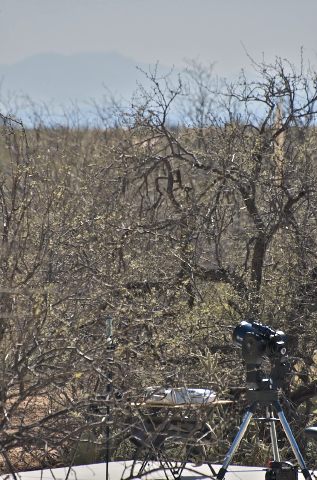
Here's a better view of Kitt Peak from the house. Kitt Peak is 65 miles from the house. You can see the Mayall 4-meter telescope dome sticking up right of center, and if you look closely, you can see the triangular-shaped McMath-Pierce Solar Observatory left of center.
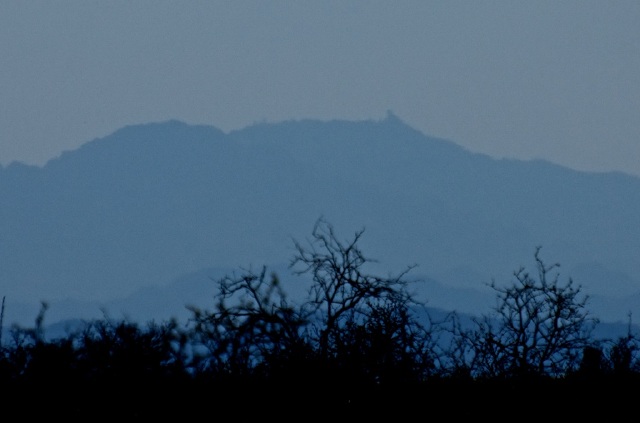
The photo was taken with a 70-300mm telephoto lens (set to 300mm). The sky was hazy so the definition is not great.
After I completed setting up, I did some solar observing with the PST. Several nice prominences were easily seen, including one rather large one.
Following that, I did a walk-around our three acres of land and took some photos:
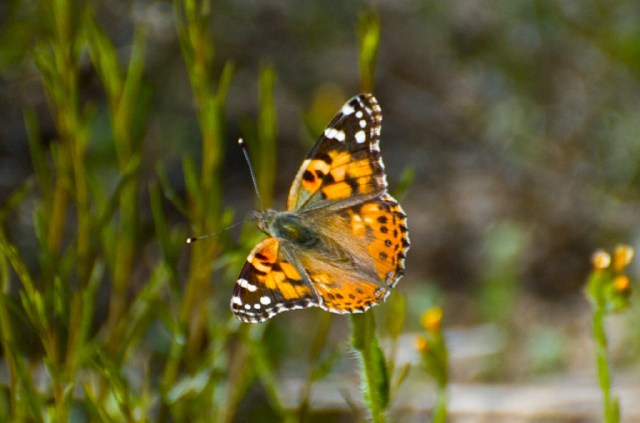

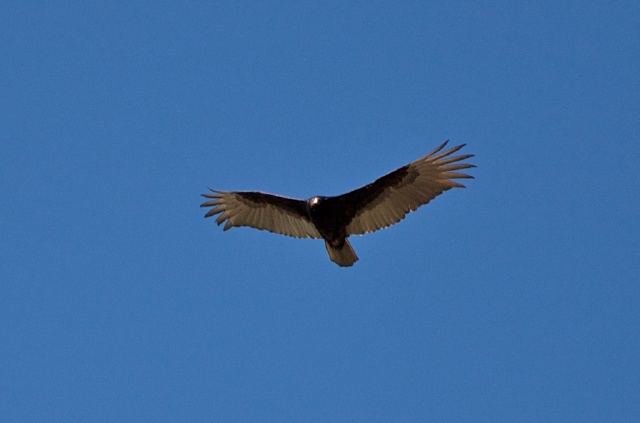
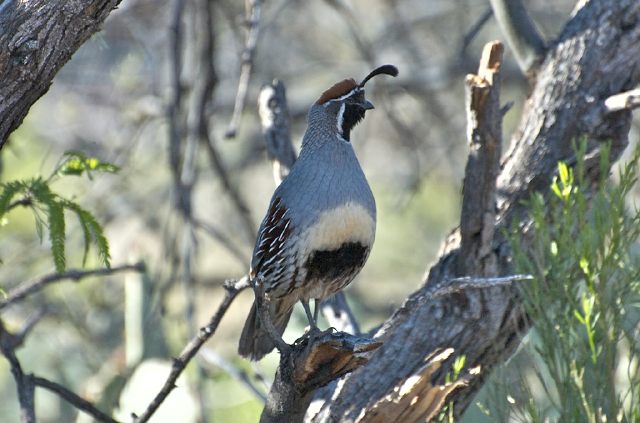
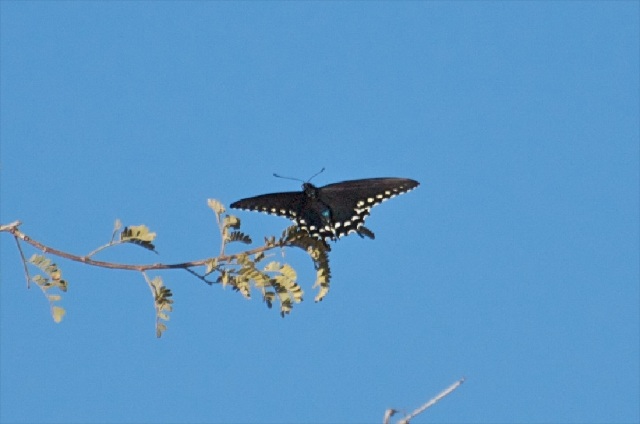
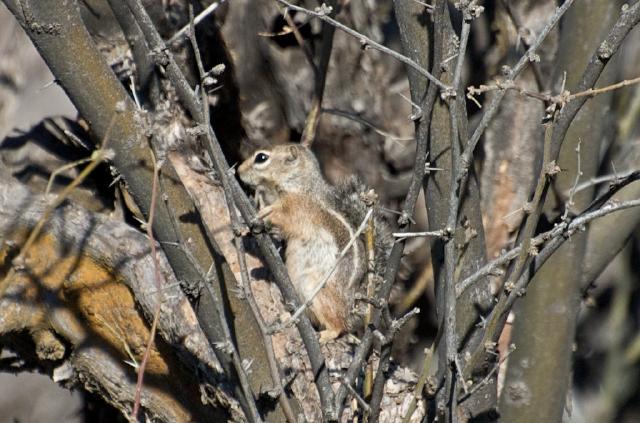
I have been going to Oracle Observatory for four years and this was the first time that I've seen a roadrunner on our land. He first appeared about 15 feet from me but was going away from me when I got this photograph:
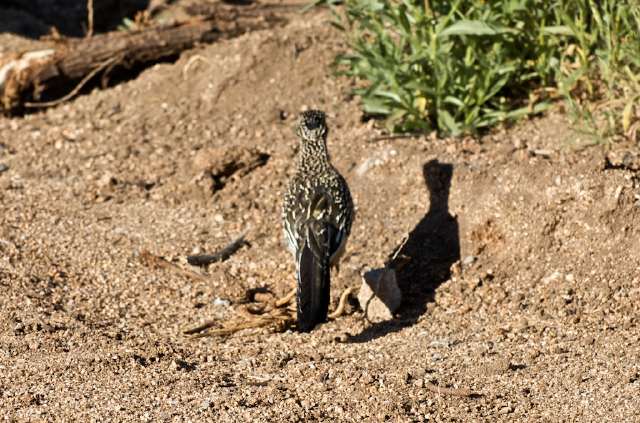
He then headed up to the house:
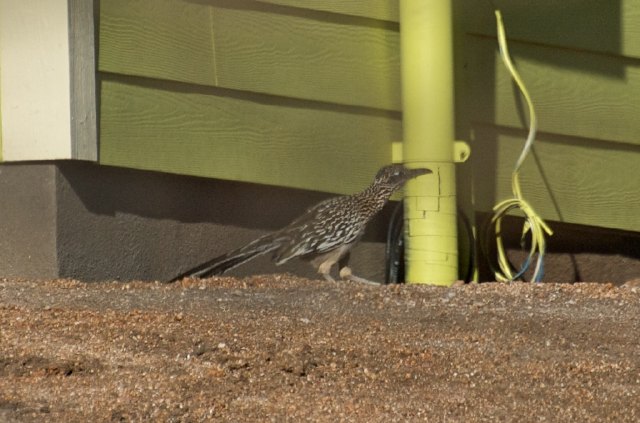
At 1745 MST, I did some more solar observing. The large prominence seen earlier in the day now seemed flatter than it did then. I used a 9.7mm eyepiece to view more details.
Sunset at 1845 MST was nice. The sky was clear (although somewhat hazy). Here you can see the sun setting near Picacho Peak:
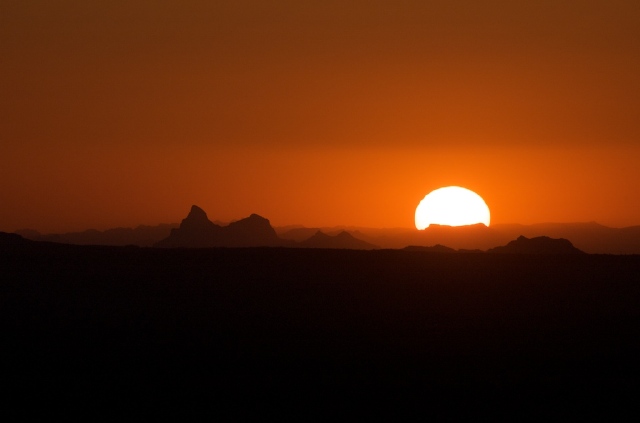
Shortly after sunset I took this photo of the 2-day, 12-hour old, crescent moon with the 70-300mm telephoto lens (set to 300mm):
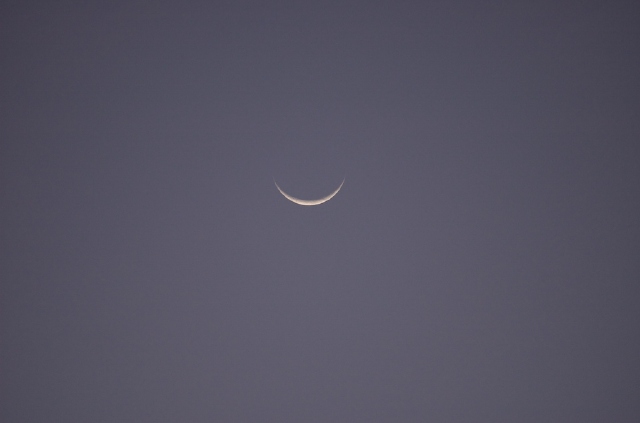
I then attached my Nikon D70 DSLR to the 8" LX200-ACF telescope (still powered off) and took this photo at prime focus:
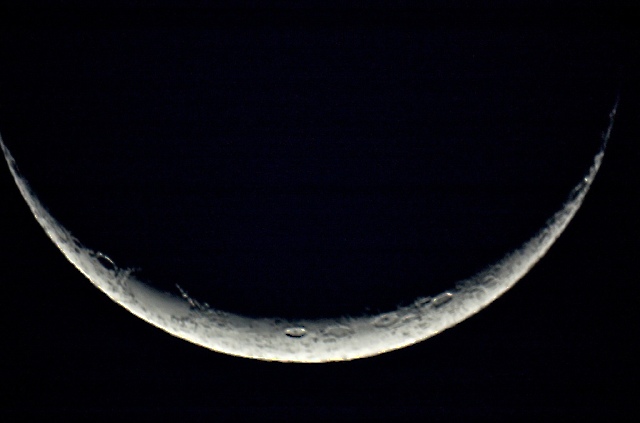
At 1925 MST, temperature 51°F, I powered up the 8" telescope and did the alignment. I then did a GOTO the moon; it was perfectly centered in the 26mm eyepiece (77X). Starting at 1934 MST I began observing several objects. First up was Saturn. Although seeing was not great, with a 15mm eyepiece (133X) I could easily see three moons of Saturn: Titan, Rhea, and Dione. I then viewed M42, the Great Nebula in Orion. Always a nice object from a dark site! I then looked at NGC3242, the Ghost of Jupiter. The color was a nice glowing blue, with a hint of details visible. However, the view was not as nice as from a week ago when I looked at the Ghost of Jupiter through the WIYN 3.5-meter telescope on Kitt Peak.
At 2010 MST, temperature 49°F, I began doing some astrophotography. I first did a D70 DSLR focus on Sirius using the Spike-a™ Bahtinov Mask. As I was making a note about this focus step in my log book, the area around me was illuminated by a bright white light. I looked up to the east and saw a rapidly dissipating trail of a meteor (or probably a fireball) low in the eastern sky. Wish I had seen the actual meteor (or fireball)!
First was M42. This was a 2 minute exposure, ISO 1250, at prime focus of the 8" f/10 telescope. Unfortunately, the battery died just as the in-camera noise reduction process started (hence the glow in the upper lefthand corner). But it is still a nice image, with lots of detail visible.
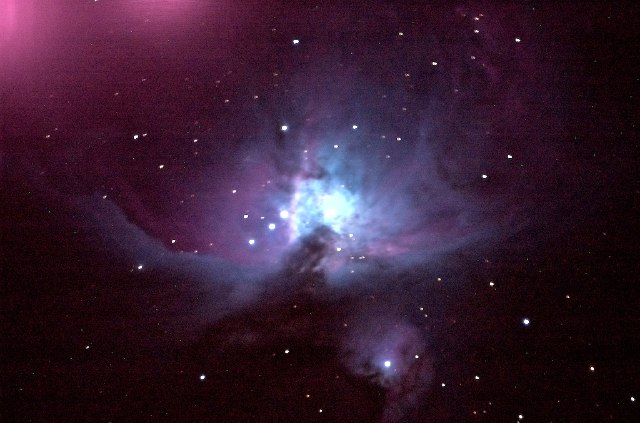
Here is an image of the Ghost of Jupiter. It is a 2 minute exposure, ISO 1250, at prime focus. The image was cropped from the original full-frame image. There is a lot of detail in the image, even with such a short exposure.
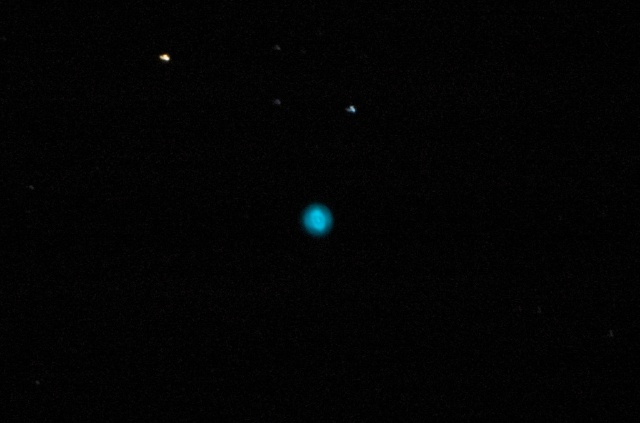
Here is Saturn using eyepiece projection with a 9.7mm eyepiece (206X). The rings are almost edge-on. Some of the cloud bands are visible.
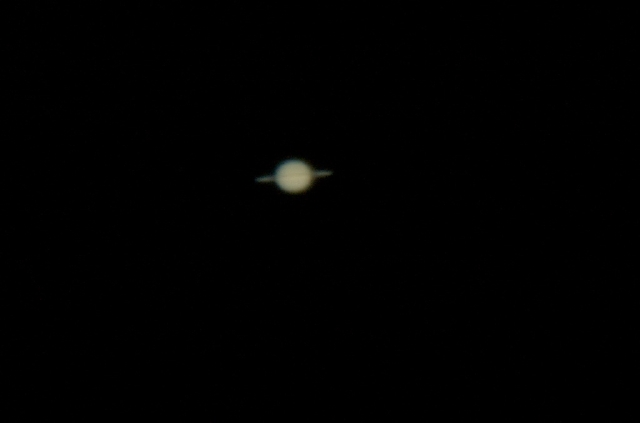
I then tried to photograph Saturn using afocal photography with my Apple iPhone and a 9.7mm eyepiece plus 2X Barlow Lens. Unfortunately, the image overexposed (no manual exposure controls on the iPhone).
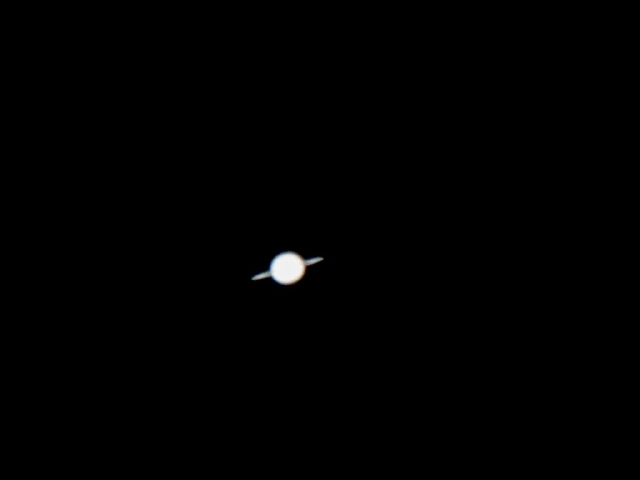
I attempted to photograph M42 with the iPhone but all I got were stars (the Trapezium cluster is visible):
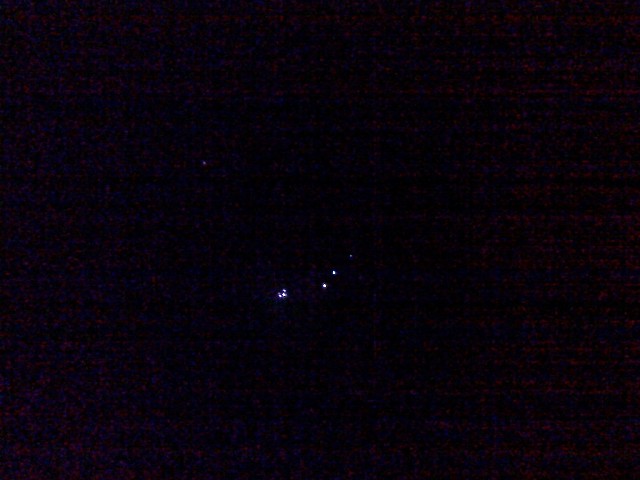
At 2032 MST, I did the Globe at Night sky magnitude check. I was able to detect Magnitude 7 stars (barely). The skies have been hazy here lately.
I next spent some time looking at several objects. Thanks to an article in the May 2009 issue of Sky and Telescope magazine, I looked at the galaxies M65, M66, and NGC3628. All three appeared in the 26mm eyepiece (77X) field-of-view (FOV), although each galaxy was near the edge of the FOV. I switched to my 2" 30mm wide angle eyepiece (67X); now all three galaxies were easily seen in the FOV. Nice! Next was M104, the Sombrero Galaxy. I used a 15mm eyepiece (133X); it was good with averted vision. Next, I used the 2" 30mm eyepiece to view the galaxies M101, M51, M81, M82. All were lovely.
After completing the visual work, I resumed D70 DSLR astrophotography. Here is M104, the Sombrero Galaxy; 2 minute exposure, ISO 1600, cropped from original image. A longer exposure, or additional images for stacking would improve it (next time). But you can still see the dust lane going laterally across the galaxy.
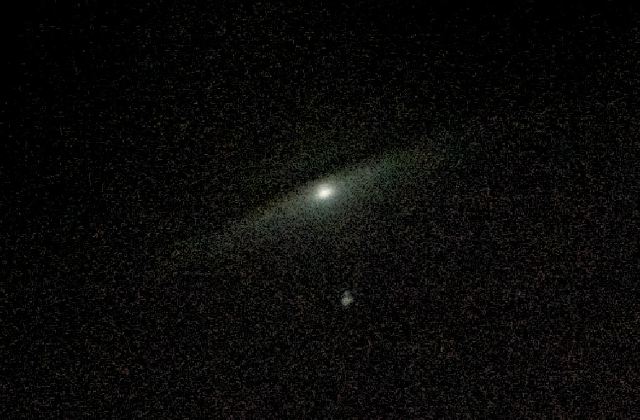
At 2245 MST, temperature 46°F, I retired to the tent to rest and listen to some Old Time Radio (Tales of the Texas Rangers) on my Apple iPod. At 0010 MST, 43°F, I came back outside to resume viewing and astrophotography. I looked at the Omega Centauri globular cluster. Although it was just above the southern horizon, it was gorgeous in the 26mm eyepiece (77X). I started to photograph it when some clouds that were low in the south moved over it. Phooey. The clouds were moving northward so I decided to move my viewing northward as well. First, was M13, the Great Globular Cluster in Hercules. Here is a 1 minute exposure, ISO 1600, image of it at prime focus:
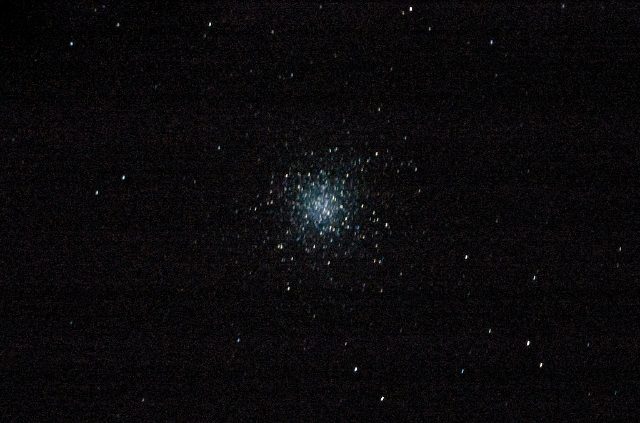
I then slewed the telescope to the nearby M92 globular cluster and imaged it (1 minute, ISO 1600, prime focus):
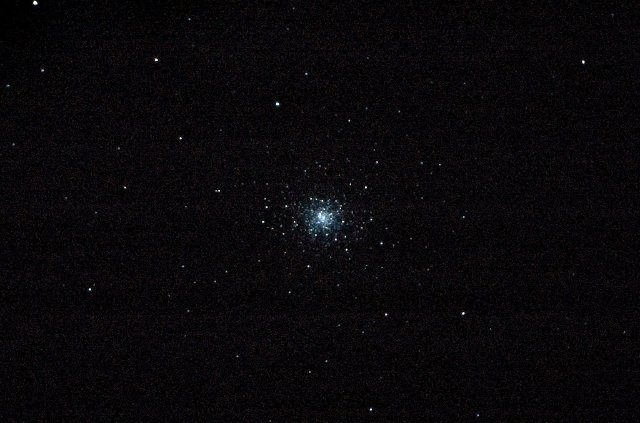
I took a quick look at M92 with the 15mm eyepiece (133X). Lovely!
At 0040 MST, 42°F, with the clouds in the south continuing to move to the north, I decided to call it a night. I woke up at 0630 MST, temperature 48°F, with partly cloudy skies. I checked the forecast and although it was currently calm, the winds were forecast to get strong and the skies to remain partly cloudy. I decided to pack up and leave. As I was packing up the last two items the winds were starting to blow. I departed Oracle Observatory at 0830 MST. It was a nice visit.
Return to the Oracle Observatory Main Page.